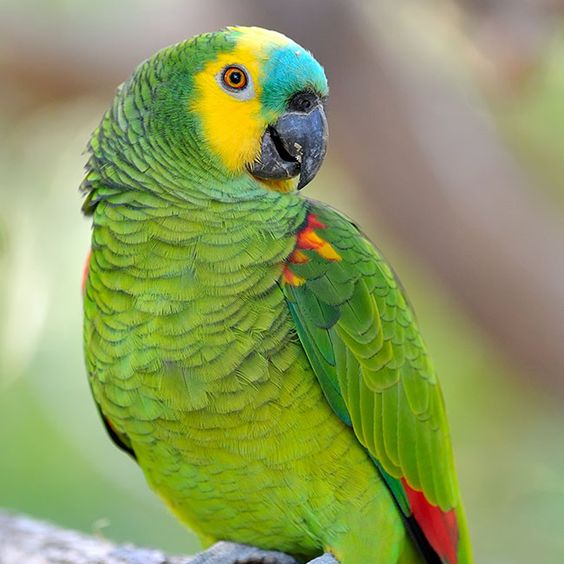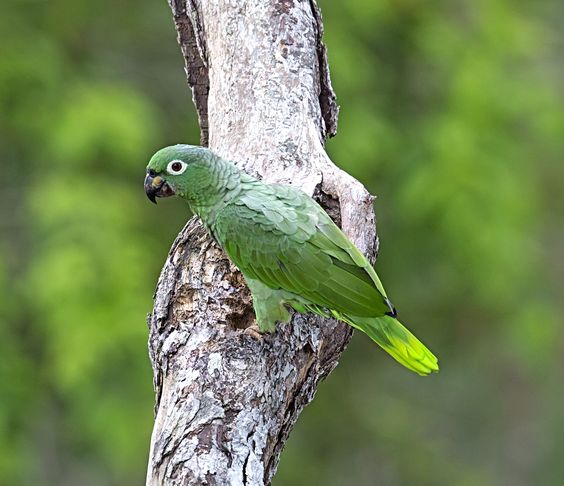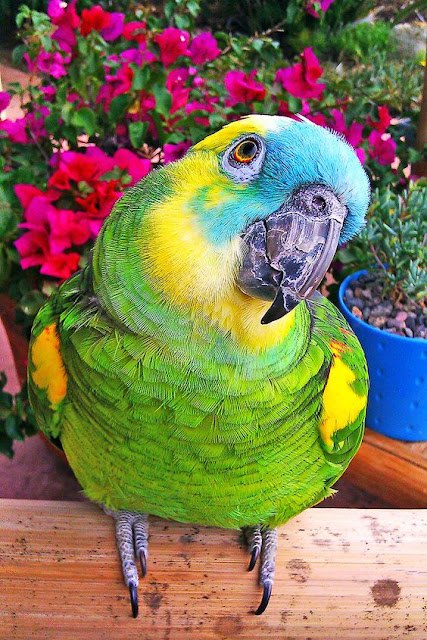Most amazon parrots are predominantly green, with accenting colors that depend on the species and can be quite vivid. They feed primarily on seeds, nuts, and fruits, supplemented by leafy matter.
Many amazon parrots have a remarkable ability to mimic human speech and other sounds. Partly because of this, they are popular as pets or companion parrots, and a small industry has developed in breeding parrots in captivity for this market. This popularity has led to many parrots being taken from the wild to the extent that some species have become threatened. The Convention on International Trade in Endangered Species of Wild Fauna and Flora treaty has made the capture of wild parrots for the pet trade illegal in an attempt to help protect wild populations.
Taxonomy and naming
The genus Amazona (to which amazons belong) was established by René Lesson in 1830. It was a Latinized version of the name Amazone given to them in the 18th century by the Comte de Buffon, who believed they were native to Amazonian jungles.
List of species:
- Cuban amazon, Amazona leucocephala
- Yellow-billed amazon, Amazona collaria
- Hispaniolan amazon, Amazona ventralis
- Puerto Rican amazon, Amazona vittata
- Yucatan amazon, Amazona xantholora
- White-fronted amazon, Amazona albifrons
- Black-billed amazon, Amazona agilis
- Tucumán amazon, Amazona tucumana
- Red-spectacled amazon, Amazona pretrei
- Red-crowned amazon, Amazona viridigenalis
- Lilac-crowned amazon, Amazona finschi
- Red-lored amazon, Amazona autumnalis
- Lilacine amazon, Amazona autumnalis
- lilacina Diademed amazon, Amazona diadema
- Blue-cheeked amazon, Amazona dufresniana
- Red-browed amazon, Amazona rhodocorytha
- Red-tailed amazon, Amazona brasiliensis
- Festive amazon, Amazona festiva
- Yellow-shouldered amazon, Amazona barbadensis
- Turquoise-fronted amazon, Amazona aestiva
- Yellow-crowned amazon, Amazona ochrocephala
- Panama amazon, Amazona ochrocephala panamensis
- Yellow-naped amazon, Amazona auropalliata
- Yellow-headed amazon, Amazona oratrix
- Tres Marías amazon, Amazona tresmariae
- Kawall's amazon, Amazona kawalli
- Orange-winged amazon, Amazona amazonica
- Scaly-naped amazon, Amazona mercenarius
- Southern mealy amazon, Amazona farinosa
- Northern mealy amazon, Amazona guatemalae
- Vinaceous-breasted amazon, Amazona vinacea
- Saint Lucia amazon, Amazona versicolor
- Red-necked amazon, Amazona arausiaca
- Saint Vincent amazon, Amazona guildingii
- Imperial amazon, Amazona imperialis
- Blue-winged amazon, Amazona gomezgarzai
The taxonomy of the yellow-crowned amazon is disputed, with some authorities only listing a single species,while others split it into as many as three species.The split is primarily based on differences related to extension of yellow to the plumage and the colour of bill and legs. Phylogenetic analysis of mtDNA do not support the traditional split.
Reclassification of the yellow-faced parrot
The yellow-faced parrot (Alipiopsitta xanthops) was traditionally placed within this genus of amazon parrots, but recent research has shown that it is closer to the short-tailed parrot and the species from the genus Pionus, resulting in it being transferred to the monotypic genus Alipiopsitta.
Hypothetically extinct species
Populations of amazon parrots that lived on the Caribbean islands of Martinique and Guadeloupe are now extinct. It is not known if they were separate species, subspecies, or if they originated from parrots introduced to the islands by humans, so they are regarded as hypothetical extinct species. No evidence of them remains, and their taxonomy may never be established. Populations of several parrot species were described mainly in the unscientific writings of early travelers, and subsequently scientifically described by several naturalists mainly in the 20th century, with no more evidence than the earlier observations and without specimens.An illustration of a specimen termed "George Edwards' parrot" has sometimes been considered a possibly distinct, extinct species, but it may also have been a yellow-billed or Cuban amazon with aberrant colouration.
- Martinique amazon, Amazona martinica (hypothetical extinct species). A.H. Clark, 1905.
- Guadeloupe amazon, Amazona violacea (hypothetical extinct species). Originally called Psittacus violaceus by J.F. Gmelin in 1789
Aviculture
The yellow-headed amazon, yellow-naped amazon, orange-winged amazon, and turquoise-fronted amazon are some of the amazon parrot species which are commonly kept as pets. Amazon parrots, together with macaws and the grey parrot, are all known for their exceptional vocal abilities, playfulness, and dexterity with their feet. Well-trained parrots can be loyal companions, and they can live for 50 years or sometimes more in captivity. However, some amazons - even well-trained ones - can become aggressive, possibly during mating season. To maintain health and happiness, pet parrots require much more training than domesticated animals such as dogs or even cats. They require understanding, manipulative toys, and rewards for good pet-like behavior, or they can develop quite aggressive behaviors. They have a strong, innate need to chew, thus require safe, destructible toys.
Source: Wiki



















No comments:
Post a Comment